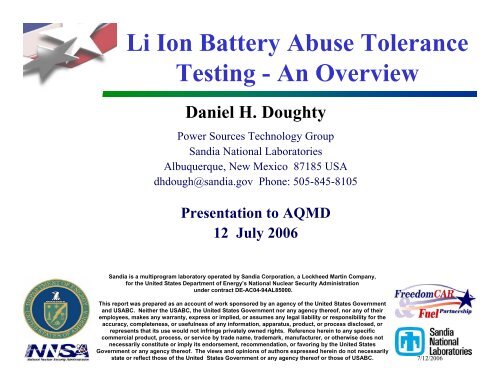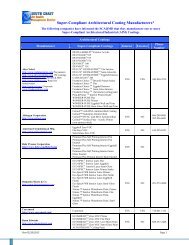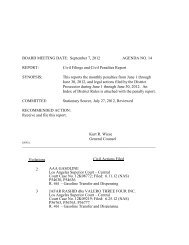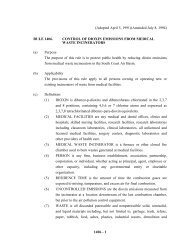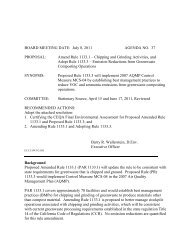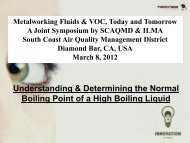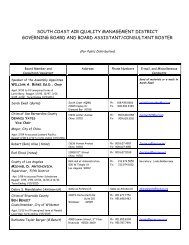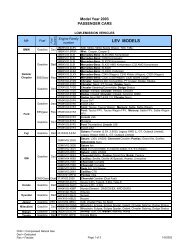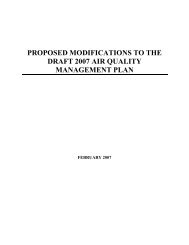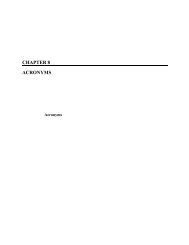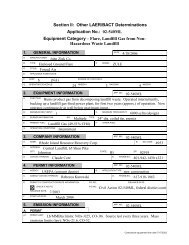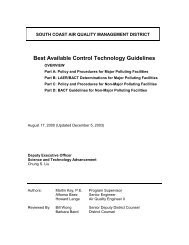Li Ion Battery Abuse Tolerance Testing - An Overview
Li Ion Battery Abuse Tolerance Testing - An Overview
Li Ion Battery Abuse Tolerance Testing - An Overview
Create successful ePaper yourself
Turn your PDF publications into a flip-book with our unique Google optimized e-Paper software.
<strong>Li</strong> <strong>Ion</strong> <strong>Battery</strong> <strong>Abuse</strong> <strong>Tolerance</strong><br />
<strong>Testing</strong> - <strong>An</strong> <strong>Overview</strong><br />
Daniel H. Doughty<br />
Power Sources Technology Group<br />
Sandia National Laboratories<br />
Albuquerque, New Mexico 87185 USA<br />
dhdough@sandia.gov Phone: 505-845-8105<br />
Presentation to AQMD<br />
12 July 2006<br />
Sandia is a multiprogram laboratory operated by Sandia Corporation, a Lockheed Martin Company,<br />
for the United States Department of Energy’s National Nuclear Security Administration<br />
under contract DE-AC04-94AL85000.<br />
This report was prepared as an account of work sponsored by an agency of the United States Government<br />
and USABC. Neither the USABC, the United States Government nor any agency thereof, nor any of their<br />
employees, makes any warranty, express or implied, or assumes any legal liability or responsibility for the<br />
accuracy, completeness, or usefulness of any information, apparatus, product, or process disclosed, or<br />
represents that its use would not infringe privately owned rights. Reference herein to any specific<br />
commercial product, process, or service by trade name, trademark, manufacturer, or otherwise does not<br />
necessarily constitute or imply its endorsement, recommendation, or favoring by the United States<br />
Government or any agency thereof. The views and opinions of authors expressed herein do not necessarily<br />
Presentation to AQMD 0607b.ppt<br />
1<br />
state or reflect those of the United States Government or any agency thereof or those of USABC.<br />
7/12/2006
Presentation to AQMD 0607b.ppt<br />
2<br />
Outline<br />
• Description of <strong>Abuse</strong> <strong>Tolerance</strong> Objectives.<br />
• Introduction to the US Dept. of Energy’s Advanced<br />
Technology Development (ATD) Program<br />
• Thermal <strong>Abuse</strong> test results<br />
– Characterized the scientific basis for heat and gas-producing<br />
reactions.<br />
• Overcharge <strong>Abuse</strong> test results<br />
– Shows the need for standardized testing protocols.<br />
– Determine the conditions and mechanisms affecting<br />
overcharge abuse tolerance<br />
• Summary and Conclusions.<br />
7/12/2006
Presentation to AQMD 0607b.ppt<br />
Description of Study Objectives<br />
• SNL is investigating the abuse tolerance of <strong>Li</strong> <strong>Ion</strong> and other<br />
types of cells and batteries for the DOE<br />
– Investigation of prototype cells and commercial cells to develop<br />
Mechanistic Understanding of abuse response.<br />
• Information is open and published (and is the subject of this talk).<br />
– <strong>Abuse</strong> <strong>Testing</strong> of pre-production battery packs being developed for<br />
DOE’s FreedomCAR Hybrid Vehicle Program.<br />
• Test Manual was written by SNL staff and accepted the by the Society of<br />
Automotive Engineers - SAE J2464 (1999) Recommended Practice “Electric<br />
Vehicle <strong>Battery</strong> <strong>Abuse</strong> <strong>Testing</strong>”<br />
• Manual has been modified for HEV <strong>Battery</strong> Packs (SAND2005-3123)<br />
• Test results are proprietary.<br />
3<br />
7/12/2006
Presentation to AQMD 0607b.ppt<br />
The Purpose of <strong>Abuse</strong> Tests is to<br />
Evaluate the Response Of Test Articles<br />
to Off-normal Environments<br />
• CHARACTERIZATION tests which evaluate the response to<br />
abuse environments are important for developmental<br />
technology.<br />
– Usually results in failure of the test article.<br />
– Documentation of conditions that cause failure.<br />
– Evaluate failure modes and abuse conditions using destructive physical<br />
analysis (DPA)<br />
– Provide quantitative measurements of cell/module response.<br />
• Electrical performance as well as chemical analysis (evolved gas)<br />
– Helps identify optimum battery design approaches and safety margins.<br />
– Document improvements in abuse tolerance.<br />
• PASS/FAIL testing is the type of approach that Underwriters<br />
Lab (UL) or Department of Transportation (DoT) defines.<br />
– Doesn’t provide mechanistic information.<br />
– We typically don’t perform these tests.<br />
4<br />
7/12/2006
Our <strong>Abuse</strong> <strong>Tolerance</strong> <strong>Testing</strong> for EV<br />
& HEV is Relevant to Plug-In HEVs<br />
• PHEV battery pack will be intermediate in<br />
size between EV and HEV.<br />
• <strong>Abuse</strong> conditions for EV and HEV are<br />
relevant to PHEV.<br />
• <strong>Abuse</strong> Environments include electrical &<br />
physical abuse.<br />
• Overcharge and short circuit are most common electrical<br />
abuse.<br />
• High Temperature and crush are the most common<br />
physical abuse.<br />
Presentation to AQMD 0607b.ppt<br />
5<br />
7/12/2006
Presentation to AQMD 0607b.ppt<br />
DOE’s Advanced Technology<br />
Development (ATD) Program Helps<br />
Mature Advanced <strong>Battery</strong> Technology<br />
• DOE’s Advanced Technology Development (ATD) Program<br />
addresses the three barriers that remain for insertion of<br />
advanced batteries in hybrid electric vehicles -<br />
– high cost, short calendar life, and poor abuse tolerance.<br />
• FreedomCAR is Stakeholder (through USABC)<br />
• Focus is <strong>Li</strong> <strong>Ion</strong> Rechargeable Chemistry<br />
• Involves 5 US National Laboratories<br />
– Sandia National Labs, Argonne National Lab, Lawrence Berkeley National<br />
Lab, Idaho National Engineering & Environmental Lab, and Brookhaven<br />
National Lab<br />
• Technical goal is to<br />
– Develop improved diagnostic techniques at National Labs.<br />
– Identify and solve life-limiting mechanisms for failure of<br />
lithium-ion cells during abuse and aging<br />
6<br />
7/12/2006
Heat Rate (C/min)<br />
1<br />
0.8<br />
0.6<br />
0.4<br />
0.2<br />
0<br />
The Thermal <strong>Abuse</strong> Response of <strong>Li</strong><br />
<strong>Ion</strong> Cells Is Described In Three Stages<br />
•Accelerating Rate Calorimetry (ARC) measures self-heating rate for cells.<br />
•Adiabatic test is “worst case” environment.<br />
•Data for SONY/GEN1/GEN2 ATD Cells at 100% State of Charge (SOC)<br />
100%SOC<br />
Sony Cell Vent<br />
Seaparator<br />
Melt<br />
GEN2<br />
Stage 1 Stage 2 Stage 3<br />
Initial thermal<br />
runaway/ramp regime<br />
SONY<br />
Cell venting<br />
Presentation to AQMD 0607b.ppt<br />
Cell runaway and<br />
explosive<br />
decomposition<br />
GEN1<br />
0 50 100 150<br />
Temperature (C)<br />
200 250 300<br />
7<br />
Rate (C/min)<br />
350<br />
300<br />
250<br />
200<br />
150<br />
100<br />
50<br />
0<br />
Stage 3 – Note Expanded Self-Heating Rate Scale<br />
Cell runaway and explosive decomposition<br />
2.2 min<br />
0 50 100 150 200 250 300 350 400 450<br />
Temperature (C)<br />
7/12/2006
EUCAR Traction <strong>Battery</strong> Safety Test<br />
Description* Has Been Used<br />
to Characterize <strong>Abuse</strong> Response<br />
Hazard Level Description Classification Criteria, Effect<br />
0 No effect No effect, no loss of functionality.<br />
1 Passive No defect, no leakage, no venting, no fire or flame, no rupture,<br />
Protection no explosion, no exothermic reaction or thermal runaway.<br />
activated Cell reversibly damaged. Repair of protection device needed.<br />
2 Defect / Damage No leakage, no venting, no fire or flame, no rupture,<br />
no explosion, no exothermic reaction or thermal runaway.<br />
Cell irreversibly damaged, repair needed<br />
3 Leakage No venting, no fire or flame**, no rupture, no explosion,<br />
∆m < 50% Weight loss < 50% of electrolyte weight.<br />
(electrolyte = solvent + salt)<br />
4 Venting No fire or flame**, no rupture, no explosion,<br />
∆m ≥ 50% Weight loss ≥ 50% of electrolyte weight.<br />
5 Fire or Flame No rupture, no explosion, i.e., no flying parts.<br />
6 Rupture No explosion, but flying parts, ejection of parts of the active mass.<br />
7 Explosion Explosion, i.e., disintegration of the cell.<br />
* Proceedings of EVS 21, W. Josefowitz et al., “Assessment & <strong>Testing</strong> of Advanced Energy Storage Systems for propulsion –<br />
European <strong>Testing</strong> Report”, April, 2005.<br />
** The presence of flame requires the presence of an ignition source in combination with fuel and oxidizer in concentrations that<br />
will support combustion. A fire or flame will not be observed if any of these elements are absent. For this reason, we recommend<br />
that a spark source be use during tests that are likely to result in venting of cell(s). We believe that “credible abuse environments”<br />
would likely include a spark source. Thus, if a spark source were added to the test configuration and the gas or liquid expelled<br />
from the cell was flammable, the test article would quickly progress<br />
Presentation to AQMD 0607b.ppt<br />
8 from level 3 or level 4 to level 5. (SNL Comment.)<br />
7/12/2006
Presentation to AQMD 0607b.ppt<br />
<strong>Li</strong>kelihood of <strong>Abuse</strong> Condition Is<br />
<strong>An</strong> Important Factor To Consider<br />
• When judging the readiness of a candidate<br />
technology for deployment, it is useful to evaluate<br />
whether the tests could be characterized as<br />
– “likely abuse” - a condition that is likely to inadvertently<br />
occur during “normal” use (e.g., short circuit),<br />
– “moderate abuse” - an abuse condition that is not likely, or<br />
– “extreme abuse” - an abuse condition that is very unlikely.<br />
• A catastrophic response of a cell or module (i.e.,<br />
Response Level 6 or 7) to a “likely abuse” condition<br />
should be treated much more seriously than a<br />
catastrophic response of a cell or module to an<br />
“extreme abuse” condition.<br />
9<br />
7/12/2006
Presentation to AQMD 0607b.ppt<br />
<strong>Abuse</strong> Test Conditions Must be<br />
Standardized<br />
Test conditions determine severity of response<br />
• Different test parameters can affect the observed<br />
results.<br />
• Heat dissipation is an important factor.<br />
• <strong>An</strong> example is Overcharge <strong>Abuse</strong> Test, which is<br />
affected by:<br />
– Charge rate.<br />
– Heat conduction.<br />
– Charging voltage limit (maximum compliance voltage)<br />
10<br />
7/12/2006
6% CDR Graphite<br />
EC:EMC/1.2M <strong>Li</strong>PF 6<br />
<strong>Li</strong>Ni 0.80 Co 0.15 Al 0.05 O 2<br />
Presentation to AQMD 0607b.ppt<br />
Overcharge Test Setup<br />
Allows Us to Measure Heat Output of 18650-size cells<br />
Helium or nitrogen flowing through lexan<br />
enclosure for real time gas sampling<br />
and Control Temperature Profile<br />
11<br />
Cell current/voltage leads<br />
Upper Thermocouples<br />
– Cell surface and<br />
Outside Insulation<br />
Insulation<br />
(calibrated<br />
thermal resistance)<br />
Outer Insulation<br />
Lower Thermocouples<br />
Cell TC leads<br />
Radial Heat Flow<br />
Cell<br />
Mid –<br />
Thermocouples<br />
7/12/2006
Presentation to AQMD 0607b.ppt<br />
Shutdown Separator Melt can Protect<br />
the Cell From <strong>Abuse</strong> Events<br />
18650-size cell charged at 1.0, 1.5 and 2.0 Amps.<br />
Higher Charging Rates Can Cause Separator Melt<br />
Voltage increases to maximum test voltage.<br />
Temperature declines when shutdown separator melts.<br />
12<br />
7/12/2006
Cell Temperature(C)<br />
160<br />
140<br />
120<br />
100<br />
80<br />
60<br />
40<br />
20<br />
0<br />
High Rate/High Voltage Overcharge<br />
Presentation to AQMD 0607b.ppt<br />
Causes Thermal Runaway<br />
2.7 amp charge starting at 100%SOC: N2 atmosphere<br />
Thermal Runaway (corresponds to 135C<br />
115ºC internal temperature )<br />
Avg Temp In<br />
Cell Voltage<br />
Gas Generation<br />
155%SOC<br />
100% 120% 140% 160% 180% 200%<br />
% SOC<br />
13<br />
Onset of Heat Generation<br />
125%SOC<br />
10<br />
8<br />
6<br />
4<br />
2<br />
0<br />
Cell Voltage<br />
7/12/2006
Presentation to AQMD 0607b.ppt<br />
Movie Clip of Overcharge<br />
Thermal Runaway<br />
14<br />
7/12/2006
•These pictures were taken after<br />
overcharge of a prototype HEV module at<br />
SNL <strong>Abuse</strong> Test Labs.<br />
•Small cell test results are predictive of<br />
larger scale batteries.<br />
Presentation to AQMD 0607b.ppt<br />
Overcharge of <strong>Li</strong> <strong>Ion</strong> Modules<br />
Can be Violent<br />
Protected <strong>Battery</strong> Information Hazard Level 6 - Rupture<br />
15<br />
7/12/2006
Presentation to AQMD 0607b.ppt<br />
Standardized Overcharge Test<br />
Procedures Must Be Followed<br />
By changing the overcharge test<br />
conditions, one can cause violent<br />
failure or benign response.<br />
• Overcharge abuse response is a function of charge rate,<br />
heat dissipation and overpotential.<br />
• Initial heat generation followed by gas generation at<br />
voltage peak.<br />
• High thermal impulse or high driving voltage after<br />
separator melt can result in thermal runaway.<br />
• Rapid heat dissipation and reduced compliance voltage<br />
will cause much reduced consequences to overcharge.<br />
• At Sandia we test at two overcharge rates (at a<br />
minimum).<br />
16<br />
7/12/2006
Presentation to AQMD 0607b.ppt<br />
How Do We Improve The <strong>Abuse</strong><br />
<strong>Tolerance</strong> of <strong>Li</strong> <strong>Ion</strong> Cells and Batteries?<br />
• Thermal Runaway occurs during many<br />
abuse events.<br />
• The Goal is to Reduce Heat-producing<br />
Reactions.<br />
• Understand and control gas-producing<br />
reactions.<br />
• Reduce (eliminate?) the flammability of<br />
electrolyte.<br />
• Do Shutdown Separators provide safety<br />
improvements for large battery packs?<br />
17<br />
7/12/2006
Approach for Developing Cells & <strong>Battery</strong><br />
Packs With Improved <strong>Abuse</strong> <strong>Tolerance</strong><br />
Safety arises from wise material choices<br />
and wise engineering choices.<br />
– Batteries have fuel and oxidizer sealed in a container.<br />
– Understand failure mechanisms & vulnerabilities at cell level.<br />
• Heat and gas generation reactions.<br />
– Use material substitutions where available.<br />
• <strong>An</strong>ode carbon choice can greatly influence tendency to initiate thermal<br />
runaway.<br />
• Cathode materials with less oxidizing potential.<br />
– Additives are useful to remedy certain problems.<br />
• Flammability of electrolyte.<br />
• Reduce reactivity of electrode materials with electrolyte.<br />
– Incorporate good engineering practices in cells & in modules.<br />
• Vents should reliably release cell internal pressure & expel electrolyte early<br />
enough to terminate runaway reactions.<br />
• “Shut down” separators are useful in certain situations.<br />
• Cell-to-cell charging in multi-cell series strings should be eliminated.<br />
Presentation to AQMD 0607b.ppt<br />
18<br />
7/12/2006
Presentation to AQMD 0607b.ppt<br />
Summary<br />
• <strong>Abuse</strong> <strong>Tolerance</strong> of <strong>Li</strong> <strong>Ion</strong> cells remains an issue.<br />
– Our goal is graceful failure.<br />
• Standardized <strong>Testing</strong> allows identification of<br />
problems areas and document improvements in abuse<br />
tolerance.<br />
• Understanding chemical response to abuse conditions<br />
has led to improved materials.<br />
• More stable electrode materials (anode carbon or less reactive cathodes).<br />
• Additives for improved thermal stability and reduced flammability.<br />
• Remedies in one abuse condition (e.g., thermal abuse)<br />
are likely to improve cell response in other abusive<br />
conditions (e.g., overcharge).<br />
• Good engineering practices are essential.<br />
19<br />
7/12/2006
Presentation to AQMD 0607b.ppt<br />
Acknowledgements<br />
Team at Sandia:<br />
Pete Roth, Mani Nagasubramanian, Brad Hance, Dave Johnson,<br />
Jill Langendorf, and Lori Davis<br />
This work was performed under the auspices of DOE FreedomCAR & Vehicle Technologies Office. Support from the<br />
Advanced Technology Development (ATD) High Power <strong>Battery</strong> Development Program is acknowledged.<br />
Sandia is a multiprogram laboratory operated by Sandia<br />
Corporation, a Lockheed Martin Company, for the United<br />
States Department of Energy under Contract<br />
DE-AC04-94AL85000.<br />
This report was prepared as an account of work sponsored by an agency of the United States Government and<br />
USABC. Neither the USABC, the United States Government nor any agency thereof, nor any of their employees,<br />
makes any warranty, express or implied, or assumes any legal liability or responsibility for the accuracy, completeness,<br />
or usefulness of any information, apparatus, product, or process disclosed, or represents that its use would not infringe<br />
privately owned rights. Reference herein to any specific commercial product, process, or service by trade name,<br />
trademark, manufacturer, or otherwise does not necessarily constitute or imply its endorsement, recommendation, or<br />
favoring by the United States Government or any agency thereof. The views and opinions of authors expressed herein<br />
do not necessarily state or reflect those of the United States Government or any agency thereof or those of USABC.<br />
20<br />
7/12/2006


